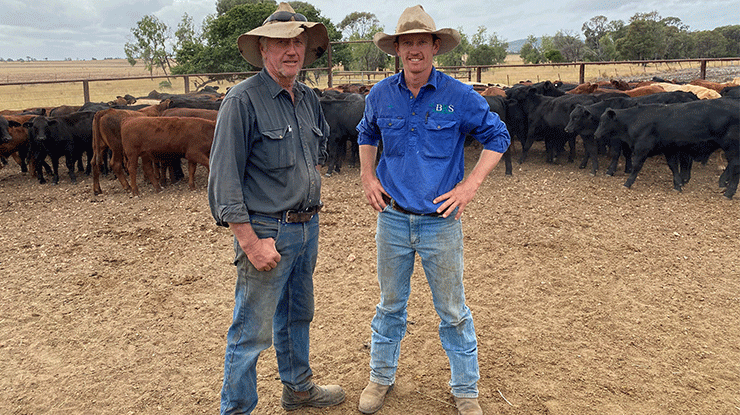 Rob Johnstone and his father, Joe.
Rob Johnstone and his father, Joe.
Full traceability of their herd's breeding and nutritional background has been fundamental to the success of the Johnstone family's Central Queensland beef enterprise.
Running a herd of 1,200, Droughtmaster, Black Angus, and Santa Gertrudis cross cattle across their 3,000 hectare property 'Can-Berra', near Banana, the Johnstones have a track record of excellent MSA performance, a feat Rob Johnstone attributes to the focus they have on both genetic traits and animal nutrition.
"We first registered with MSA back in 2007, as we could see the industry movement toward eating quality measurement and the principles meshed well with our core breeding objectives," Rob said.
"We sell predominantly into the EU market, and the engine room of our business is undoubtedly our cow herd.
"To maintain both eating quality and climatic adaptability up here, we run two main cow mobs, with Droughtmaster or Santa Gertrudis bulls going over Angus-cross females, and Angus bulls going over the Droughtmaster or Santa females.
"Our bulls play an important role in providing a good end product, and our broad breeding objectives of fertility, growth and market suitability align with MSA objectives."
Nutrition is key
Nutrition is critical from the outset for the Johnstones, with their weaners given access to a formulated ration comprising of silage and hay during the initial two-week weaning window.
"We've found that exposing weaners to this diet in the early days sets them up well to go into our backgrounding system comprising Leucaena, buffel and green panic grass. More importantly it allows for a more streamlined transition onto our finishing ration later in life," Rob said.
"If the season cuts out, we also have the ability to supplement cattle with urea, ammonium sulphate and trace minerals, dispensed using water medicators.
"Making sure our young stock never want for anything during the backgrounding phase helps ensure the quality of the end product, and by running them in one contemporary mob we can easily analyse MSA feedback against their history on-farm, which helps identify issues and eliminate any variables."
MSA recommends that cattle are kept on a rising plane of nutrition at a level that is adequate for growth for a minimum of 30 days prior to consignment, and that cattle are run as one mob for a minimum of 14 days prior to consignment.
Above-average results
The Johnstones placed 55th in the 2019 MSA Excellence in Eating Quality Top 100 for Queensland.
The 2019 Excellence in Eating Quality Awards assessed MSA compliance and Index results from the 2017-19 financial years, during which time the Johnstones consigned 674 head for MSA grading and achieved an average MSA Index of 58.23, which is almost two Index points higher than the Queensland average of 56.26.
They also achieved an average compliance rate of 98.5%, which is more than five percent points higher than Queensland's average MSA compliance rate of 93.3% for the same time period.
From approximately 20 months of age, steers over 480 kilograms and cull females over 420 kilograms go onto a 100-day formulated ration, comprising of roughly 18 kilograms per animal per day on an as fed basis of corn or barley silage, grain and straw.
"We make minor tweaks in the feed ration depending on season, but have been fairly consistent in this approach over the years and this consistency is reflected in our MSA data," Rob said.
"Because we can fully control the animal's nutrition in the feedlot setup, and we grow most of our own silage, grain and hay, we are able to keep the quality and nutritional value high which has a direct correlation with the animal's performance."
Outside the feedlot, the Johnstones rotationally graze their cattle which helps them further enhance animal nutrition by ensuring there is a bulk of nutritious feed ahead of the mobs every time they are moved.
Finessing the end article
Rob said beyond managing nutritional variables, they also aim to run a mostly self-replacing herd.
"This gives us a really good understanding of what animals we have from the get-go and gives us near total control, both in terms of nutrition and other important genetic traits like temperament, which we know directly correlate to the quality of the end product," Rob said.
"We've found this consistency to be absolutely critical to our MSA compliance, as it's only when you can eliminate variables that you can really finesse the end article."
The Johnstones see the MSA framework as key to better outcomes for the whole supply chain.
"Indirectly, whether you're selling straight off the mother or into a feedlot, if you can align your production objectives with the MSA framework, then your customer is going to prefer your cattle because they can be assured that the outcomes align with their expectations" Rob said.
"Looking critically at your production system and using MSA feedback to identify opportunities will ultimately lead to the production of better cattle, and enhance relationships with your customers, whoever they are."
myMSA has been refreshed
myMSA has been updated, giving MSA producers access to a range of new features including:
- Opportunity Index: The Opportunity Index helps you focus your attention on where financial gains can be made and to benchmark carcase attribute performance. It tells you what your Index would have been if non-compliant carcases met the MSA minimum requirements.
- New look and feel: the myMSA portal has been refreshed and is easier to use. New features include:
- Easy navigation on the left-hand menu
- Help prompts on every page
- Accessible on every device.
Access your carcase feedback, MSA Index results and benchmark the eating quality performance of your herd at www.mymsa.com.au





